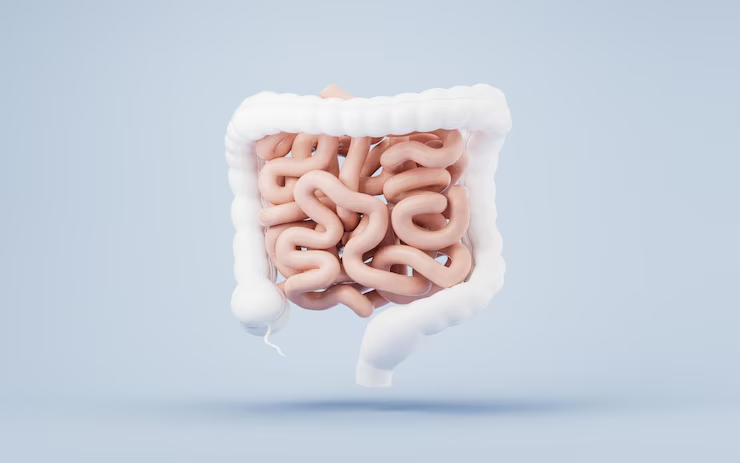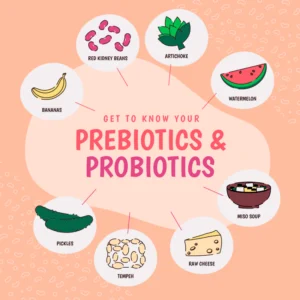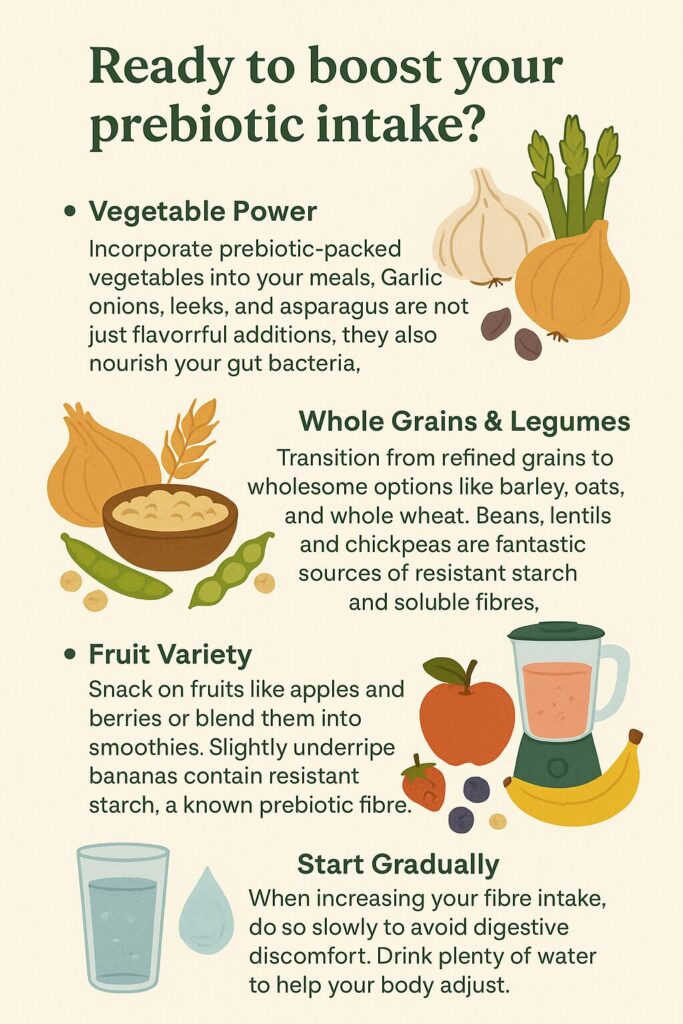Prebiotics vs. Probiotics : 5 Secrets for Amazing Gut Health

In recent years, gut health has become one of the most talked-about topics in wellness. From digestion and immunity to mental clarity and mood, research now shows that the gut microbiome home to trillions of microorganisms, plays a central role in overall health.
Among the most discussed components of gut health are probiotics and prebiotics. Though often used interchangeably, these two are distinct yet interdependent players in maintaining a balanced gut ecosystem. Understanding their roles, differences, and sources can help you make informed choices to strengthen your digestive health and overall well-being.
Table of Contents
What Are Probiotics?
Probiotics are essentially the “good” bacteria, live microorganisms that, when taken in adequate amounts, provide a plethora of health benefits. Think of them as your body’s allies in maintaining a balanced gut environment.
Sources of Probiotics
~ Fermented foods such as yogurt, kefir, miso, kimchi, sauerkraut, tempeh, and kombucha
~ Probiotic supplements containing strains like Lactobacillus, Bifidobacterium, and Saccharomyces boulardii
Benefits of Probiotics
1. Improved Digestion:
Probiotics aid in breaking down food, enhancing nutrient absorption, and preventing issues such as bloating, constipation, and diarrhea.
2. Enhanced Immunity:
Around 70% of the immune system resides in the gut. A balanced microbiome helps strengthen immune responses, reducing susceptibility to infections and allergies.
3. Restored Gut Balance:
After antibiotic use or illness, probiotics help replenish beneficial bacteria, restoring equilibrium and preventing overgrowth of harmful microbes.
4. Mental Well-being:
Through the gut–brain axis, certain probiotic strains can influence mood and stress by producing neurotransmitters like serotonin and GABA.
A 2023 review published in MedComm found that probiotics not only aid digestion but also play a role in regulating immune responses and reducing gut inflammation (Ji et al., 2023). The study highlighted their potential in managing conditions like irritable bowel syndrome (IBS) and inflammatory bowel disease (IBD).
Enter Prebiotics
On the flip side, we have prebiotics; the unsung heroes of gut health. These are non-digestible fibres and compounds that serve as the food for the beneficial bacteria in your gut. Unlike probiotics, prebiotics aren’t live organisms; instead, they nourish and stimulate the growth and activity of probiotics, allowing them to thrive.
Sources of Prebiotics:
~ Garlic, onions, leeks, asparagus, and artichokes
~ Whole grains such as oats and barley
~ Legumes like chickpeas, lentils, and beans
~ Green (unripe) bananas and cooked-cooled rice or potatoes
Benefits of Prebiotics
1. Fuel for Probiotics:
Prebiotics provide the nourishment that beneficial bacteria require to multiply and function effectively.
2. Improved Gut Barrier:
They help strengthen the gut lining, reducing the risk of leaky gut and chronic inflammation.
3. Better Nutrient Absorption:
Prebiotics enhance the absorption of vital minerals such as calcium and magnesium, supporting bone health and metabolism.
4. Balanced Immunity and Inflammation:
By promoting the production of short-chain fatty acids (SCFAs) like butyrate, prebiotics reduce inflammation and support immune homeostasis.
According to Brown University Health, prebiotics serve as essential nourishment for beneficial gut bacteria. Their fermentation leads to the production of short-chain fatty acids (SCFAs), which help strengthen the intestinal lining and reduce inflammation — both crucial for overall gut and immune health.
The Key Differences : Prebiotics vs. Probiotics
| Prebiotics | Probiotics |
| Live microorganisms that, when administered in adequate amounts confer a health benefit on the host. | Nondigestible food ingredients that beneficially stimulate growth and/or activity of gut bacteria. |
| Bacteria or yeast, often from fermented foods like yogurt. Examples: Lactobacillus, Bifidobacterium. | Typically dietary fibers or other carbohydrates. Examples include inulin, Fructo-oligosaccharides and galacto-oligosaccharides |
| Can colonize the gut, enhancing its microbial balance. They can produce postbiotics. | Provide food for beneficial bacteria, promoting their growth and activity. |
| Sensitive to environmental conditions like temperature and stomach acid. | Generally stable and not affected by temperature or stomach acid. |
| Can cause infections in immunocompromised individuals. | Overconsumption can lead to gastrointestinal discomfort. |
| Yogurt, kefir, fermented foods, certain supplements. | Foods like garlic, onions, asparagus, and whole grains. |

Studies show that maintaining a balance of both prebiotics and probiotics enhances nutrient absorption and supports the gut-brain axis, linking gut health to better mood regulation and mental well-being (Kechagia et al., 2013).
Why Prebiotics Matter?
Prebiotics are crucial for gut health because they serve as food for the beneficial bacteria in your gut, promoting their growth and activity. These non-digestible fibres pass through the digestive tract to the colon, where they are fermented by gut bacteria. This fermentation process produces short-chain fatty acids, which strengthen the gut lining, reduce inflammation, and enhance nutrient absorption, like calcium and magnesium. By fostering a thriving microbiome, prebiotics help maintain digestive balance, support immune function, and may even influence mental health through the gut-brain axis, making them an essential component of overall wellness.

Let’s Talk About Resistant Starches
Resistant starches are a type of prebiotic fibre that “resist” digestion in the small intestine and ferment in the large intestine — where they feed beneficial bacteria.
Sources of Resistant Starch:
Cooked and cooled potatoes, pasta or rice, Green (unripe) bananas, Legumes like lentils and, chickpeas, Rolled oats
These starches help increase insulin sensitivity, promote fullness, and further encourage the growth of gut-friendly bacteria, making them a powerful addition to your daily diet.
Emerging evidence suggests that resistant starches may improve metabolic health by increasing insulin sensitivity and fostering beneficial gut microbes. This makes them a key player in managing blood sugar and supporting weight balance.
The Gut–Brain Axis: More Than Digestion
Emerging science reveals that gut health extends far beyond digestion. The gut and brain are connected through a complex communication network called the gut–brain axis, involving the nervous system, immune signals, and microbial metabolites.
When gut bacteria are in balance, they produce neurotransmitters and metabolites that positively influence mood, sleep, and cognitive function. Conversely, an unhealthy gut can lead to inflammation that disrupts these pathways, contributing to fatigue, anxiety, or mood swings.
Maintaining a diverse microbiome through both prebiotic and probiotic intake supports not only physical health but also emotional and mental resilience.
Pink Tiger Verification
At Pink Tiger, we go beyond just recommending supplements. Our verification process includes rigorous quality checks, third-party testing, and expert reviews, which take time to ensure only the best products are approved. By doing this, we help ensure that you are choosing gut health supplements that are not only effective but also clean, science-backed, and aligned with your health goals.

Stay tuned for updates on verified products. Check out: https://youcarelifestyle.com/
Conclusion
Understanding the synergy between prebiotics and probiotics is key to cultivating lasting gut health. Probiotics introduce beneficial bacteria, while prebiotics provide them with the nourishment they need to thrive. Together, they create a balanced and diverse gut ecosystem supporting digestion, immunity, energy, and even mood.
Incorporate both through whole foods whenever possible, and consider high-quality, verified supplements when dietary intake isn’t sufficient. With consistent attention to your gut, you support the foundation of holistic health, because a happy gut truly means a healthier you.
Frequently Asked Questions (FAQs)
1. Can I take prebiotics and probiotics together?
Yes, and doing so may provide the best of both worlds. When taken together, they create what’s called a synbiotic effect. This means that the prebiotics (the food) nourish the probiotics (the live bacteria), enhancing their survival and effectiveness in the gut. For example, consuming yogurt (probiotic) with oats or bananas (prebiotic) creates an ideal environment for beneficial bacteria to thrive. Synbiotic combinations help improve digestion, strengthen immunity, and restore balance after antibiotic use or digestive disturbances. However, moderation is key.
2. Do I need supplements if I eat probiotic foods like curd or yogurt?
If you regularly eat fermented foods such as curd, yogurt, kefir, or buttermilk, you’re already supporting your gut with live probiotic cultures. These foods contain beneficial strains like Lactobacillus acidophilus and Bifidobacterium bifidum, which help balance gut bacteria and improve digestion.
However, the probiotic count and diversity in foods can vary depending on how they’re made and stored. Homemade or freshly fermented products usually contain more active cultures, while packaged varieties may have fewer live bacteria due to pasteurization or refrigeration time.
3. Are prebiotics and dietary fiber the same thing?
Not quite. While all prebiotics are forms of dietary fiber, not all fibers qualify as prebiotics. Prebiotics are specific non-digestible fibers, such as inulin, fructooligosaccharides (FOS), and resistant starch, that serve as food for your beneficial gut bacteria. Regular fibers, like cellulose, mainly add bulk to stool and support bowel movement, but prebiotics go a step further by feeding the good bacteria, helping them multiply and outcompete harmful ones.
4. How can I add resistant starches to my diet easily?
You can effortlessly increase your intake of resistant starches through simple daily habits. Foods like cooked and cooled potatoes, rice, and pasta become rich in resistant starch when chilled, as the cooling process changes their structure, making them less digestible and more beneficial for gut bacteria. You can also include green (unripe) bananas, lentils, and rolled oats in your meals.
Try blending cooled rice into salads, adding chickpeas to curries, or using overnight oats for breakfast. These minor tweaks not only improve gut health but also help regulate blood sugar, increase satiety, and enhance insulin sensitivity.
5. What happens if I don’t get enough prebiotics or probiotics?
An imbalance in gut bacteria, known as dysbiosis, can lead to digestive issues like bloating, constipation, low immunity, and even mood swings. Over time, a lack of beneficial microbes can contribute to inflammation, poor nutrient absorption, and a weaker gut barrier. Including both prebiotics and probiotics regularly ensures your gut ecosystem stays balanced and resilient.
Disclaimer: This content is for informational purposes only and is not a substitute for professional medical advice, diagnosis, or treatment. Always consult a qualified healthcare provider for any questions or concerns regarding your health.
References :
1. The Importance of Prebiotics | Brown University Health. (n.d.). Brown University Health. Retrieved June 12, 2025, from https://www.brownhealth.org/be-well/importance-prebiotics
2. Ji, J., Jin, W., Liu, S., Jiao, Z., & Li, X. (2023, November 4). Probiotics, Prebiotics, and Postbiotics in Health and Disease. MedComm. Retrieved June 10, 2025, from https://pmc.ncbi.nlm.nih.gov/articles/PMC10625129/
3. Kechagia, M., Basoulis, D., Konstantopoulou, S., Dimitriadi, D., Gyftopoulou, K., Skarmoutsou, N., & Fakiri, E. M. (2013, January 2). Health Benefits of Probiotics: A Review. ISRN Nutrition. Retrieved June 12, 2025, from https://pmc.ncbi.nlm.nih.gov/articles/PMC4045285/